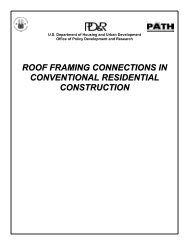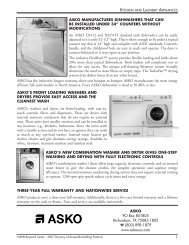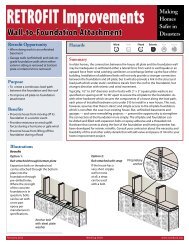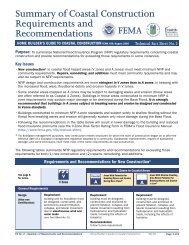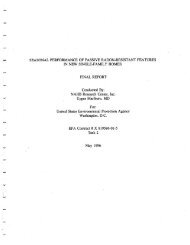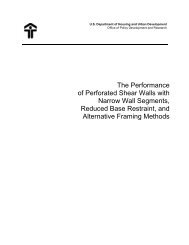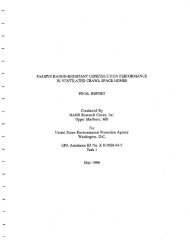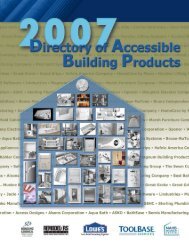The Rehab Guide, Volume 2: Exterior Walls - ToolBase Services
The Rehab Guide, Volume 2: Exterior Walls - ToolBase Services
The Rehab Guide, Volume 2: Exterior Walls - ToolBase Services
You also want an ePaper? Increase the reach of your titles
YUMPU automatically turns print PDFs into web optimized ePapers that Google loves.
insulation, which can be replaced if necessary. Install new vinyl siding as per manufacturer’s installationrequirements. Note that vinyl siding requires a smooth, even, rigid substrate such as plywood, wood composition,rigid foam insulation, or fiber sheathing. It cannot be installed directly to structural framing orit will sag and deflect between framing members. (Failure to establish a smooth solid substrate mayconstitute a misapplication under the terms of the warranty.)2. Apply rigid or semi-rigid (e.g. FoamCore by International Paper) sheathing to existingsiding to provide a smooth substrate. Nail securely through old siding and into framing members. Flashas necessary around projections and openings.3 Apply vertical furring strips to old siding to strengthen and straighten uneven surfaces. <strong>The</strong>napply rigid sheathing as described in example 1 above. Vinyl siding cannot be applied directly over furring.Residing over existing material will require jamb and trim extensions.Vinyl siding should be applied with corrosion resistant nails (aluminum or galvanized) with aminimum 3 /4 inch penetration into wood or wood composition substrate. When foam sheathing is useddirectly over studs, nails must penetrate studs by at least 3 /4 inch. Nails should be driven so that the headsare 1 /16 to 1 /8 inch away from the slotted nailing tab to allow for shingle movement. Pneumatic staplers ornailers can be used but can bind siding more easily (especially staples) than hand nailing, unless used byan experienced installer. Individual manufacturers’ installation guidelines should be followed carefully.ADVANTAGES: Better quality vinyl siding replicates wood siding appearance. New formulations, textures,colors, and details are now available that allow more choice and improve the appearance of most architecturalstyles. A relatively low maintenance product.DISADVANTAGES: Vinyl siding, especially the thinner products, might appear wavy and will reflect theirregularity of some substrates. Expands and contracts more than other siding materials. Thinner gagesare susceptible to “oil canning” and may become brittle over time. Overdriven or improperly placedfasteners can resist siding movement and cause buckling. Colors, especially dark ones, will fade overextended periods. Vinyl siding is not weatherproof and requires a weather barrier.FURTHER READING“Application Instructions,” Vinyl Siding Institute, the Society of Plastics Industry Inc., 1994.“Cleaning of Vinyl Siding,” Vinyl Siding Institute, the Society of Plastics Industry Inc., 1994.“Fire Properties,” Vinyl Siding Institute, the Society of Plastics Industry Inc., 1994.“Installation <strong>Guide</strong> for Vinyl Siding and Accessories,” Wolverine/Certainteed, 1998; 888–838–8100;www.vinylsiding.com.“Vinyl Siding,” George Schamback, <strong>The</strong> Journal of Light Construction, June 1997, pp. 27–31.PRODUCT INFORMATIONVinyl Siding Institute, 1801 K Street, Suite 600K, Washington, DC 20006; 888–FORVSI–1; www.vinylsiding.org.(A complete list of member companies, their web sites and products, can be obtained from theVinyl Siding Institute.)Progressive Foam Products, Beach City, Ohio; 800–860–3636; www.progressivefoam.com.TechWall–VIPCO, 1441 Universal Drive, Columbus, OH 43216; 800–366–8472; www.crane-plastics.com.Foam-Core–International Paper, P.O. Box 1839, Statesville, NC 08687–1839; 800–438–1701;www.ipaper.com.48



